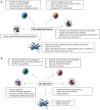Modulatory Effects of Antibody Replacement Therapy to Innate and Adaptive Immune Cells
- PMID: 28670314
- PMCID: PMC5472665
- DOI: 10.3389/fimmu.2017.00697
Modulatory Effects of Antibody Replacement Therapy to Innate and Adaptive Immune Cells
Abstract
Intravenous immunoglobulin administered at replacement dosages modulates innate and adaptive immune cells in primary antibody deficiencies (PAD) in a different manner to what observed when high dosages are used or when their effect is analyzed by in vitro experimental conditions. The effects seem to be beneficial on innate cells in that dendritic cells maturate, pro-inflammatory monocytes decrease, and neutrophil function is preserved. The effects are less clear on adaptive immune cells. IVIg induced a transient increase of Treg and a long-term increase of CD4 cells. More complex and less understood is the interplay of IVIg with defective B cells of PAD patients. The paucity of data underlies the need of more studies on patients with PAD before drawing conclusions on the in vivo mechanisms of action of IVIg based on in vitro investigations.
Keywords: IVIg replacement; X-linked agammaglobulinemia; adaptive immunity; common variable immune disorders; in vivo; innate immunity.
Figures
Similar articles
-
Intravenous Immunoglobulin and Immunomodulation of B-Cell - in vitro and in vivo Effects.Front Immunol. 2015 Jan 22;6:4. doi: 10.3389/fimmu.2015.00004. eCollection 2015. Front Immunol. 2015. PMID: 25657650 Free PMC article. Review.
-
Intravenous immunoglobulin induces proliferation and immunoglobulin synthesis from B cells of patients with common variable immunodeficiency: a mechanism underlying the beneficial effect of IVIg in primary immunodeficiencies.J Autoimmun. 2011 Feb;36(1):9-15. doi: 10.1016/j.jaut.2010.09.006. Epub 2010 Dec 9. J Autoimmun. 2011. PMID: 20970960
-
Modulation of the cellular immune system by intravenous immunoglobulin.Trends Immunol. 2008 Dec;29(12):608-15. doi: 10.1016/j.it.2008.08.004. Epub 2008 Oct 14. Trends Immunol. 2008. PMID: 18926775 Review.
-
Induction of Regulatory T Cells by Intravenous Immunoglobulin: A Bridge between Adaptive and Innate Immunity.Front Immunol. 2015 Sep 11;6:469. doi: 10.3389/fimmu.2015.00469. eCollection 2015. Front Immunol. 2015. PMID: 26441974 Free PMC article. Review.
-
Intravenous immunoglobulin replacement induces an in vivo reduction of inflammatory monocytes and retains the monocyte ability to respond to bacterial stimulation in patients with common variable immunodeficiencies.Int Immunopharmacol. 2015 Sep;28(1):596-603. doi: 10.1016/j.intimp.2015.07.017. Epub 2015 Jul 28. Int Immunopharmacol. 2015. PMID: 26232049 Clinical Trial.
Cited by
-
Immunological characterization of IgG subclass deficiency reveals decreased Tregs and increased circulating costimulatory and regulatory immune checkpoints.Front Immunol. 2024 Aug 14;15:1442749. doi: 10.3389/fimmu.2024.1442749. eCollection 2024. Front Immunol. 2024. PMID: 39206195 Free PMC article.
-
The Immune Response to SARS-CoV-2 Vaccination: Insights Learned From Adult Patients With Common Variable Immune Deficiency.Front Immunol. 2022 Jan 19;12:815404. doi: 10.3389/fimmu.2021.815404. eCollection 2021. Front Immunol. 2022. PMID: 35126372 Free PMC article.
-
An updated perspective on immunoglobulin replacement in chronic lymphocytic leukaemia in the era of targeted therapies.Front Oncol. 2023 Apr 6;13:1135812. doi: 10.3389/fonc.2023.1135812. eCollection 2023. Front Oncol. 2023. PMID: 37091176 Free PMC article. Review.
-
Multisystem Inflammatory Syndrome in Children (MIS-C), a Post-viral Myocarditis and Systemic Vasculitis-A Critical Review of Its Pathogenesis and Treatment.Front Pediatr. 2020 Dec 16;8:626182. doi: 10.3389/fped.2020.626182. eCollection 2020. Front Pediatr. 2020. PMID: 33425823 Free PMC article. Review.
-
Monitoring of immunoglobulin treatment compliance of patients with an inborn error of immunity during the pandemic period.BMC Immunol. 2025 Mar 15;26(1):22. doi: 10.1186/s12865-025-00703-w. BMC Immunol. 2025. PMID: 40089660 Free PMC article.
References
LinkOut - more resources
Full Text Sources
Other Literature Sources
Molecular Biology Databases
Research Materials


